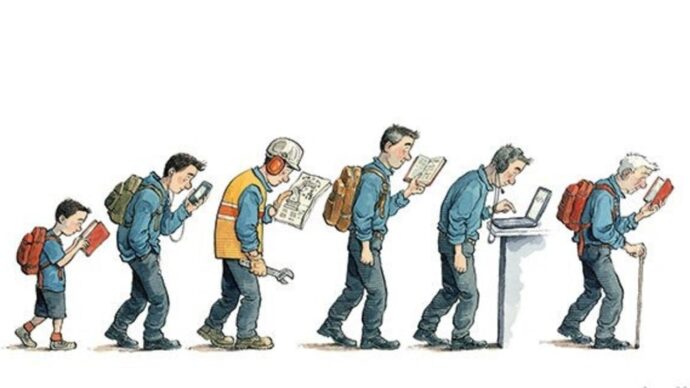Technology advances, labor is automated, and therefore many professions become obsolete over time. For example, there are no longer any telephonists or cab drivers, but there are more and more IT specialists and copywriters.
Professions that pass the test of time are also changing. However, new responsibilities are also appearing. To always remain in demand as a professional, it is important to follow the principle of lifelong learning.
This concept emerged back in the 1960s. The idea is to develop and gain new knowledge with the help of different forms of learning, most often – outside of classical education, such as studies at university or college.
Development of new skills in courses This can include the development of soft skills – flexible skills that help in the workplace. For example, a course on public speaking can teach you how to present your ideas to even the most difficult clients. A course on proper time management will optimize teamwork and save valuable minutes for other tasks.
Courses can also teach hard skills – the hard skills that form the basis of a job. For example, to learn information about big data in order to change your profession or go into a related field.
Self-education

All the knowledge you can get on your own: learn a new language using phrasebooks, learn more about graphic design from YouTube videos, listen to podcasts on psychology, and read professional literature on the structure of the programming language. Also you can always contact the EssayAssistant service for help with your studies.
Learning with new technologies
Often apps and websites can help more than an educator at a university. For example, you can learn English not only with reference books but also by increasing your speaking skills in the Lingualeo or Duolingo app.
Books
It may not be the most modern, but it is one of the most effective tools of self-education. Libraries and bookstores can meet almost any need.
Webinars and online lessons
There are a large number of formats available, but they are all aimed at one thing: to allow you to learn throughout your life. How many free platforms help you learn on your own.
What are the benefits of lifelong learning
- First, it is the main trend of the XXI century, that is, a person will always be with relevant knowledge and skills.
- Secondly, LL is good for health. Research on the brains of healthy people 14-79 years old has shown that new neural connections are created without problems at any age.
- Third, LL becomes part of the culture, as do, for example, large dinner parties for guests.
How parents can help their children master lifelong learning
Parents should help their children to set appropriate learning goals, motivate them, and teach them self-discipline, to cope with laziness and procrastination. It is also necessary to make a plan for the self-education of the child. To do this, you need to know his interests and help select relevant sources of learning.
It is possible to distinguish different formats of learning from lifelong learning. You click here for training options available in the market
To get the most out of learning, you need to learn practical tools. They will help you learn faster, more effectively, and more interestingly, as well as to constantly improve, because in today’s world it is impossible to remain competitive without mastering new knowledge and skills.
Here are a few practical tools to help you tighten up a subject like geography
Mnemonic technique

To memorize the countries of the world, a child can draw conventional symbols. For example, Egypt is the pyramids, and Switzerland is the chocolate. So the baby will match the picture in his head with the name of the country. Then the pictures can be transferred to the map – to draw large signs inside the selected country. So it is easier to remember where and what is located.
Mind maps
These can be used to outline any topic. For example, “Minerals of Africa” can be divided into seven blocks: copper, gold, platinum, uranium, diamonds, bauxite, and manganese. And then, picture them schematically and deal with each one individually.
Speed Reading
Slow reading makes a person constantly distracted, quickly tired, and, most importantly, unable to keep up with the growing volume of digital information. With speed reading, a child can read quickly and memorize large amounts of data more easily.
This format is relevant in retellings: for example, after reading a chapter quickly, invite your child to talk about three main ideas or facts from the text.
The basics of time management
Of course, this skill is not only necessary for studying geography, but it will come in handy here as well. One of the most common methods of time management is the Tomato method. It can be used to accomplish a task within a certain amount of time, followed by a short break. To alternate between work and rest, you use a timer (originally a regular kitchen one in the form of a tomato – hence the name).
Thanks to this method, you can ask your child to write an essay, for example, about minerals that are in Africa, make an outline map, or do homework.
How to implement lifelong learning

A few concrete steps can help you build a system of lifelong learning.
- Step 1: Decide on the subjects and skills you want and need for your future profession
For example, if you want to study journalism, you need to know English, literature, law, and social sciences. These are the disciplines that must be emphasized in his/her studies. Of soft skills – communication skills, and critical thinking. Hard skills – fact-checking, ability to work with large amounts of information.
- Step 2: Choose several topics that can be studied in a single period – a week or a month.
For example, start with social studies and work your way through “The U.S. Legal system”.
- Step 3: Determine a study plan for yourself by which the child will master the topics, and make a schedule.
To do this, you need to break down the topics into subtopics. For example:
– Week 1 – “Branches of Law”
– Week 2 – “Sub-branches of Law”.
– Week 3 – “Institutes of Law”.
– Week 4 -, “A summary of the material”.
- Step 4: Find the necessary online or offline resources, and consult with experienced people.
- Step 5: Make social networks your assistants and subscribe to those pages, channels, and accounts that publish quality content on the topic of interest
On legal topics, these may be lawyers, who lead social networks with posts or videos.
- Step 6. Find like-minded people with whom it will be interesting to learn together.
- Step 7: Start sharing what you have learned
To learn better, for example, you make a presentation and tell your friends, do a live broadcast, or hold an open class at school for anyone interested.
- Step 8: Repeat what we have learned from time to time and don’t stop there.
Sometimes you have to go back a couple of steps and adjust your plan.















